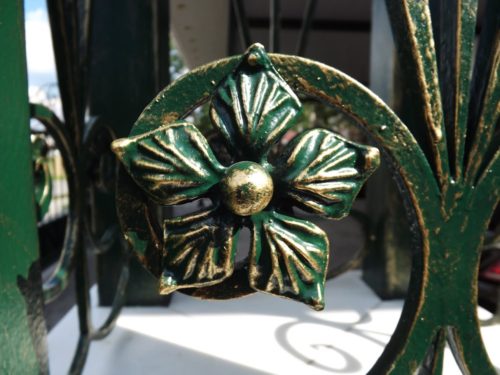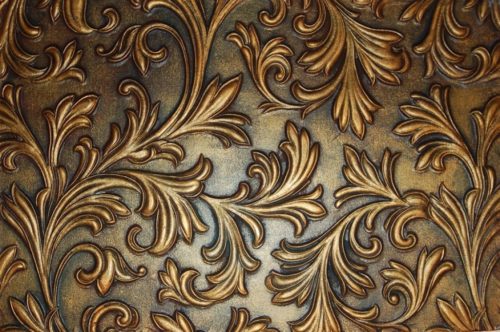
Decorative metal painting do it yourself paints and varnishes
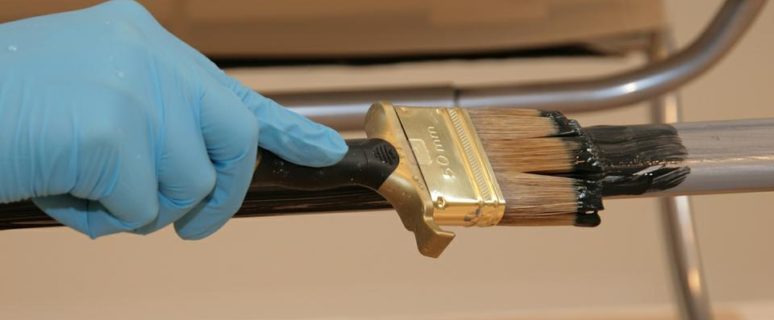
Metal surfaces in most cases require coloring, and there are several reasons. First, the outer coating will protect the material from corrosion, and secondly, even if the metal refers to stainless, paint can play a purely decorative role. In this article we will tell, what paints you can paint metal and how to do it.
Content
Choose paint for metal
In the modern market, paint materials are presented in a huge assortment, the most important thing is to choose a suitable coating from a variety of options. There are various compositions suitable for staining metal surfaces, but oil, alkyd and acrylic compositions remain the most popular and widely used.
Some metal painting polymeric substances, for example, epoxy-resin-based formulations, are rarely applied for domestic purposes. The reason for this is their toxicity, besides, the main purpose of such paints is the protection of structures from high temperatures, which is not so important in everyday life.
The basis of oil paints is Olife, which, as a rule, is made from natural oils. Such substances are well suited for painting of objects indoors, but for external work, they are infrequently used because they react poorly to high temperatures. For example, the metal roof is not choking with such a composition. In addition, over time, oil paints on the surface breathe to such an extent that they begin to crack. Water falls into cracks, and metal rust. Such materials are poorly transferred and ultraviolet radiation - they quickly fade.
Alkyd enamel is often used for metal painting. Best of all, such a coating is suitable for galvanized metal. Alkidic compositions are perfectly collected with any surface, but do not tolerate excess heating, and also differ in flammability.
Acrylic paints for metal painting are very popular. They appeared on the market relatively recently, but quickly occupied the leading positions among other materials. Such formulations serve for many years, perfectly protect the metal from rust, do not lose colors, create a solid and elastic film, do not crack. Acrylic paints are well tolerated heating, so they can be coated with heating radiators. In its composition, they do not contain harmful components and are not burning.
Among the compositions for metal painting is to highlight the paint Serebryanka. It is a fine aluminum powder, which is raised by varnished in certain proportions before applying. Such a coating creates an additional durable layer on a metal surface, characterized by a beautiful silver glitter.
You can buy a cooked composition in the store, and you can purchase a powder and make paint from it yourself. Consider more than and how to breed silver for painting metal. First you should define the type of powder - it can be a large and fine grinding. Large labeled as PAP-1, and finely dispersed - like PAP-2. The powder with large particles is poured into the tank and the BT-577 varnish is added in the 2: 5 proportion. Then substances are stirred to homogeneity and receive a pasty consistency. You can dilute the paint to a more liquid state with solvent, turbidar or another solvent.
When dad-2 silver dilution on 1 part of the powder, 3-4 parts of the varnish should be replaced with synthetic oil. Notice, natural olive in this case cannot be used. Components are best stirred by a construction mixer to achieve a homogeneous structure.
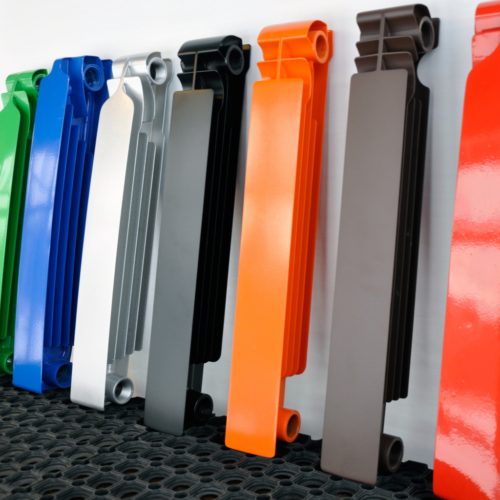
Decorative painting of metal: technology
Preparatory work
Before applying for a metal decorative coating, check the strength of the working base if it was previously painted. To do this, on the old paint, they make scratches with a knife, after which the painting ribbon is placed on these places. Then the tape is dried with a sharp movement and look at how many paint particles on it remains. If a large amount of old coating has been separated from the surface, it must be removed completely, but if the former paint is solid enough, then you can not delete it. This rule does not concern heating batteries, since each new layer on them reduces heat transfer.
Before painting metal needs to be checked for rust, dust, other contaminants. All this should be eliminated before the start of work. If you decide to remove the old coating, you can do this in several ways:
- Mechanical - with the use of special tools and abrasives.
- Chemical - using solvents or other chemical compositions.
- Thermal - with the help of a heating device.
Before the decorative painting metal, the base should not only be cleaned of the old coating, but also to degrease. What can be deguted metal before painting? There are several options. It can be done in the old manner using gasoline, acetone or kerosene. These substances are quite effective, but fires and toxic, require neat work. The modern market offers other, less dangerous, but just as effective solvents.
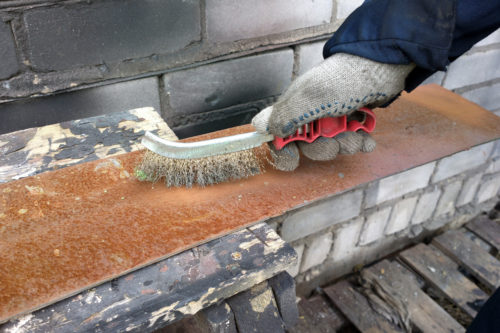
Metal priming before painting
The paint on the metal surface will hold stronger and longer if the base is preloaded. The primer also reduces the likelihood of rust on metal, prolongs the service life of the structure. Apply it with brush, roller, with a spacing or tampon. The primer layer should not be done too thick, it will be enough 0.1 mm. Subsequent paint layers should be more dense.
If the working base has any defects in the form of scratches, cracks, etc., they can be smeared with a special putty for metal. Such putty are produced from chalk, plasticizer, binder and some additives. Metal putty can be bought already diluted and ready to use, but you can purchase a powder and dissolve it yourself.

Paint metal
The paint on the metal surface is applied with a roller, brush or sprayer. It depends on the surface area, and on how it is more convenient for you to work. The brush can leave the brush on the metal, but it is easier for it to get to hard-to-reach places. Brush is also more convenient to paint small parts, narrow and small surfaces. The roller is more convenient to work on extensive and smooth areas, and the pulverizer will speed up the process of coloring of very large surfaces.
To understand how many layers of paint need, you should pay attention to such an indicator as hiding. It is determined by the manufacturer of the material and is inversely proportional to the transparency of the paint. That is, the more transparent composition, the more layers need to be applied. Information about the covers of paint can be found on the packaging of goods. The same indicator should be considered when calculating the consumption of the substance.

Patigning metal with their own hands
Today, artificially aged surfaces became very popular. The method of giving a similar effect of metal is called patinating. With the help of special materials, a metal product can be given a look of antiquity, antique, make it stylish and luxurious.
The cost of such a painting of the metal is quite high, if you contact specialists, but work can be performed on your own. Before starting work, the metal surface is prepared in the above way: purified from the old coating, remove contaminants, eliminate defects with putty, degrease and ground.
In the modern market, you can meet 2 types of decorative patina. The first type of patina works only with special paints, which include metal particles. When a patina is applied to such paint, metal components give the oxidation reaction and the metal is covered with a layer of carbon dioxide. It has a greenish hue and looks natural.
The second type of patina is made on the basis of aqueous solvents and in its composition resembles simple acrylic paints, the difference between them is only the fact that Patina is more durable. There are several shades of such material: greenish-turquoise, white, reddish-golden. It is not at all difficult to create a patinated surface with a similar material, it is not at all difficult, for this you need to be stocking with acrylic paints of gold, turquoise, gray, copper shades.
Make artificially aged metal in the following way:
- First, golden paint is applied to the prepared surface, and after 10 minutes, the working base is wiping with a damp cloth, removing excess composition. In this case, the paint remains only in the deepening relief.
- For the next stage of patina, it will take a soft, slightly disheveled brush. Her tips are macked into the paint of the copper shade and spend brush over the surface, without making pressure and leaving only individual barely noticeable strokes.
- The next step is combined with gray and turquoise paints and the working surface is completely covered with this composition.
- When the paint is dry, the metal is rubbed by sandpaper, so that through the patina she has fired the golden shade.
- The finish stage is covered with a layer of protective wax.
Tints of patina can be mixed in other combinations. For example, if you combine brown, red and yellow colors, it turns out a rusty patina. The most expressive effect of the antiquity is obtained by connecting white, black and brown paints, which are applied to the foam sponge, barely touching the surface.

